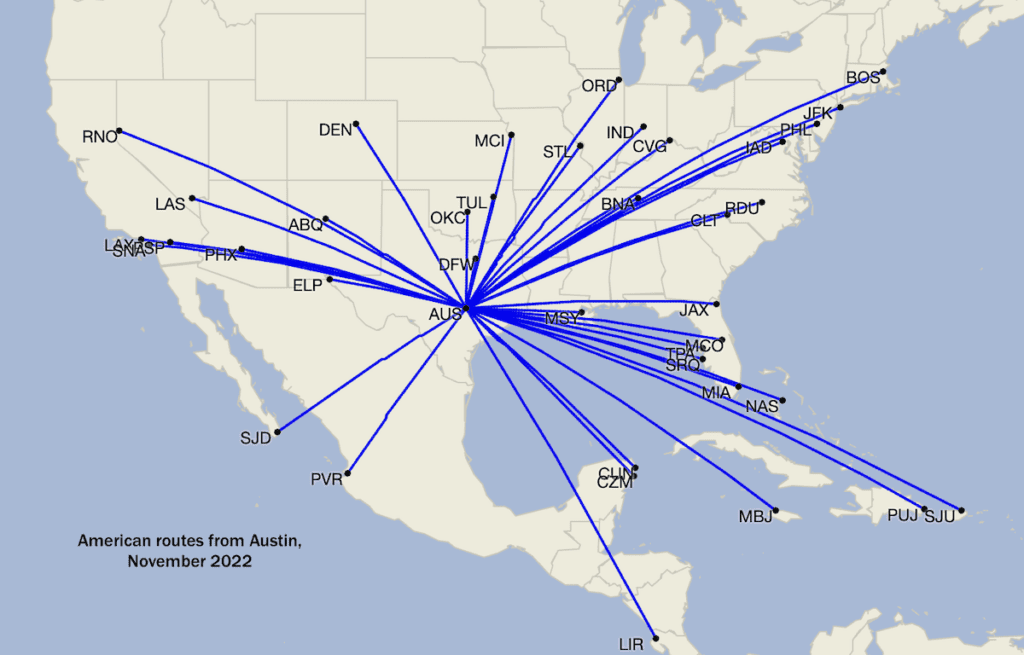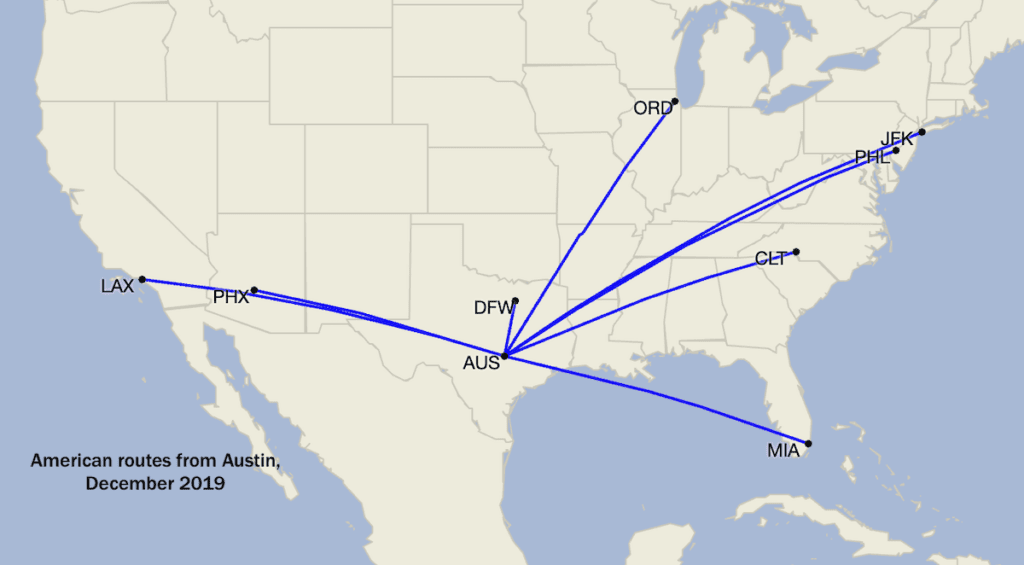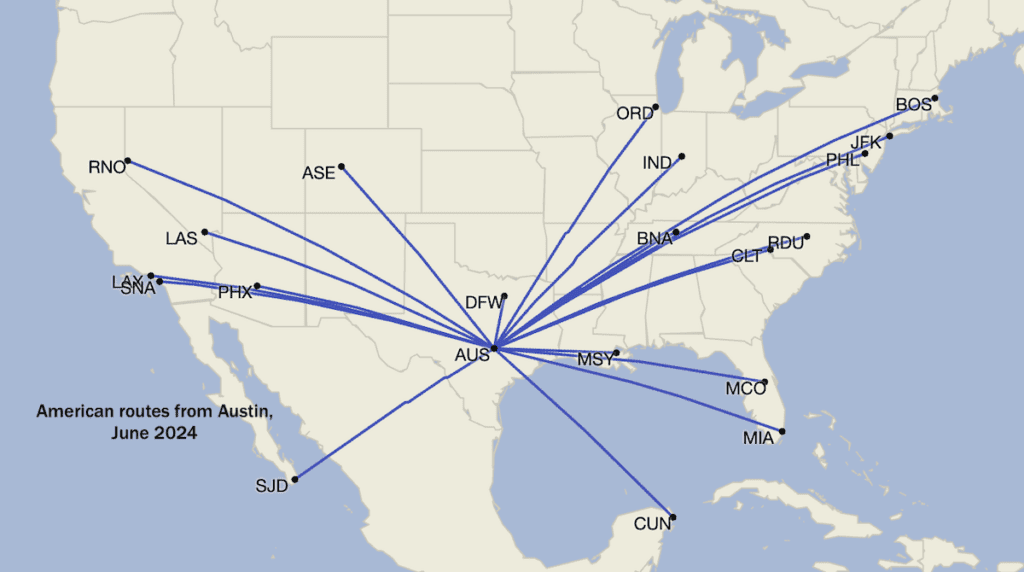American Airlines will pull 21 routes from Austin early next year. The cuts follow the exit of Virgin Atlantic Airways from the airport, which saw dramatic growth in air service as the economy exited the pandemic.
Gone are nonstop flights to Destin-Fort Walton Beach, Tampa, and Washington Dulles, to name a few, that the Fort Worth, Texas-based Oneworld alliance carrier added during the pandemic. Albuquerque, Fort Myers, Kansas City, Oklahoma City, Puerto Vallarta, Sacramento, and Vail are also among the routes cut. Flights will end in waves beginning in January and continuing through April. Several seasonal routes will not resume next summer as planned.
All said, American will fly 21% fewer seats from Austin last June than it did this June, according to Cirium Diio schedules. The airport as a whole will see 0.4% fewer seats than it did this year. Seats in June at both the airport and on American will still be up compared to 2019 by 27% and 61%, respectively.
An American spokesperson said the cuts are part of a continuous evaluation of its network
The why, however, is more complex than the airline’s official statement. One source familiar with air service in Austin said airline capacity expansion exceeded the growth in travel demand in the market. Then there are also pilot contract considerations for American. And, the airline needs planes — mostly regional — in the northeast as JetBlue Airways returns slots leased under the now defunct Northeast Alliance.
Austin Boomtown
Austin, named an “all-star” market by Airline Weekly last year, boomed during the pandemic. Alaska Airlines, Copa Airlines, Hawaiian Airlines, JetBlue, and KLM, in addition to American, Virgin Atlantic, and others, all grew with new flights and routes to the Texas capital.
Attracting them was Austin’s explosive population growth and tech company expansion that set the city up as a rival to Silicon Valley in California. According to Census estimates, the population of the Austin metropolitan area grew more than 6% to 2.4 million from 2020 through 2022. The population jumped nearly 33% during the 2010s.
Amazon, Apple, Google, and Tesla have all made, or are making, investments totaling billions of dollars in the Austin area. That has contributed to the city’s population and economic growth.
“We follow demand, and demand is generally created by GDP and population growth,” American’s head of network planning Brian Znotins said at the Skift Aviation Forum in 2022. “And Austin’s been a leading city for population growth over the past 20 years, and businesses are moving there. So it was clear that in order to compete in Austin we needed to add nonstops to Austin, not just to our hubs, but across the country.”


In the year since Znotin’s comments, however, problems have emerged in Austin. Housing costs soared along with population growth and have begun to correct downwards. And the tech boom has notably slowed since industry-wide layoffs late last year and early this year.
With the slowdown in Austin itself has come a pullback in air service. To be clear, many of the new flights — including some on American — remain, otherwise total seats at the airport would not be up more than a quarter compared to 2019. But many do not, including almost all of Alaska and JetBlue’s expansion there.
Too Many New Flights, Too Fast for Austin
“Everyone got a little out over their skis” in Austin, Ailevon Pacific Aviation Consulting Co-Founder and Managing Director Brad DiFiore said. “Everyone wanted to be there strategically … [but] it’s still growing.”
He cited, among other reasons, the slowdown in investments by tech companies around the country this year as one example.
“Demand in the tech sector is not set to improve in the near term, with corporate demand at 70% of 2019 levels,” Virgin Atlantic Chief Commercial Officer Juha Jarvinen said after the airline confirmed it would end flights to the city in January. “Therefore, sadly we made the tough decision to withdraw services.”
An Austin Airport spokesperson, asked if airlines grew too fast during the pandemic and citing American and Virgin Atlantic’s cuts, declined to comment and referred questions to the airlines themselves.
No airline grew as fast as American, in terms of total flights, in Austin. Already the second largest carrier in the market behind Southwest, it flew 117% more flights in the third quarter than it did in 2019, Cirium Diio schedules show. Southwest flew 53% more flights, Delta Air Lines 44% more, and Alaska 43% more. Interestingly, JetBlue, which made a play for Austin early in the pandemic, flew 43% fewer flights there this summer.
The growth by American, as DiFiore saw it, was an effort to block expansion by other airlines, particularly Delta, in Austin.
Delta named Austin a “focus city” shortly before the pandemic. That label, which is ambiguous but typically means some combination of nonstop flights to non-hub cities and a stepped up local sales presence, was a signal that the Texas city was strategically important to the Atlanta-based carrier. Delta has lacked a significant local presence in Texas since it closed its Dallas-Fort Worth hub in 2005.
Delta, keeping with its historic strategy, is taking a measured approach to expanding in Austin. President Glen Hauenstein reaffirmed the airline’s commitment to the city in 2021, and last month Delta added new nonstops to Las Vegas and Orlando — markets served by American, Southwest, and others — last month.
And, on a macro level, the U.S. domestic market is simply seeing too much new capacity added. That is driving down yields from their peak last year, and contributing to losses at discounters Allegiant Air, Frontier Airlines, and Spirit Airlines. Airlines face a need to make cuts to bring capacity back in line with travel demand that is described as holding “steady,” as many network carrier executives put it, at slightly above 2019 levels.
Cuts announced so far include Spirit exiting Denver, the third busiest airport in the U.S., and JetBlue exiting Burlington, Vt. Southwest is moving almost all of its international flights in Fort Lauderdale to Orlando. And now American is cutting in Austin.
American’s Pilot Scope Issue
Major U.S. airlines face strict rules in pilot contracts around their use of regional — and international — partners to serve markets. These limits are known as “scope.”
American’s contract with its pilots, represented by the Allied Pilots Association, states that 85% of flights operated by one of its regional affiliates must touch one of its hubs — Charlotte, Chicago O’Hare, Dallas-Fort Worth, Los Angeles, Miami, New York, Philadelphia, Phoenix, and Washington Reagan National. Austin is not considered a hub by the definition in the contract.
Of the 21 routes American will cut, 17 of them were exclusively flown with regional jets operated by American Eagle affiliates, Cirium Diio data show. Only four — Jacksonville, Liberia (Costa Rica), Punta Cana, and Tampa — were flown with mainline aircraft.
The Allied Pilots notified American in August that the Austin flying was in violation of the regional flight scope clause in the contract.
“Management has the mainline pilots and airplanes to fly those Austin routes but have chosen to surrender to the competition and are turning their back on the revenue opportunities in Austin,” Allied Pilots spokesperson Captain Dennis Tajer said.
Of the 21 routes American will still fly from Austin next June, 14 will be flown with mainline narrowbodies and the balance with regional jets, according to Cirium Diio.

American Needs Planes and Crews Elsewhere
American CEO Robert Isom, speaking in October, said one of the airline’s strategic initiatives next year was fully restoring its regional flying to 2019 levels. A shortage of captains and an abundance of first officers — it requires additional hours of flying to upgrade to captain from first officer — continues to limit regional capacity. American had 75 regional jets in “temporary storage” at the end of September due to staffing issues.
At the same time, American faces increasing pressure to rebuild its hubs in Chicago and Philadelphia which have been slow to come back from the pandemic. The airline also needs to either use, or risk losing, the slots at New York’s JFK and LaGuardia airports that it leased to JetBlue under the former alliance.
American has unveiled plans for new flights — all flown with regional jets — next summer between LaGuardia and Bangor, Halifax, Hyannis, Martha’s Vineyard, Nantucket, and Portland (Maine). And the number of departures from Chicago and Philadelphia will be up nearly 8% and over 6%, respectively, next June, Cirium Diio schedules show.
“There was always going to come a point, in a resource constrained environment, that you’re going to need your resources at your hub,” DiFiore said.
And, one cannot forget, American is under pressure from Wall Street to boost profits. The carrier, which is more domestic-oriented than its peers Delta and United, reported just a 5.4% operating margin excluding special items this summer. Delta’s was 12.7%, and United’s 12.2%.
Hub flying is, by and large, more profitable for an airline like American than point-to-point flying like its routes from Austin.





